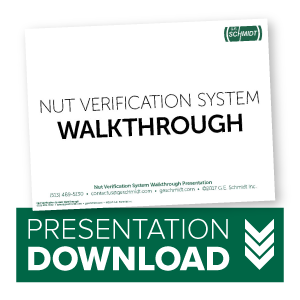Nut Verification System™ (NVS™) G-Series
Much more than a pin return unit: The ProLine Nut Verification System is the leading inline nut weld detection system in the projection welding industry. By monitoring the weld pin position, the ProLine NVS minimizes issues with missing and upside-down nuts and out-of-spec weld set-downs. Bad welds can cost much more than materials alone: Welding errors affect throughput, consistency and quality.
And say goodbye the productivity lost to the calibration and recalibration of other quality systems. Teaching the NVS a brand-new program takes just a minute, and a tare following electrode changes takes one press.
The G-Series adds a graphic user interface and a host of advanced programming options to the classic NVS to reimagine and refine nut weld detection. (NOTE: Units using the SC-500 and SC-2000 meters are still available upon request.)
New features of the NVS G-Series:
Graphic User Interface — Logical, user friendly and intuitive
Teach Function — Programming in less than one minute
Data Logging — Allows storage of NVS readings, output for easy analysis
Password Protection — Prevent unauthorized changes
Weld Profile Storage — Keep 10 fastener/stamping profiles for easy recall
Binary Input/Output — Automate profile changes on the NVS via a PLC, or change schedules on a weld control or PLC via the NVS G-Series meter
The Nut Verification System can ensure quality using standard or custom weld pins on hundreds of welders, including the advanced ProLine Adaptive Series welder, for most applications in manual or robotic weld cells. The system can also serve as a Stud Verification System in stud-welding cells.
Contact us today to discuss how the NVS G-Series can improve your projection welding system.
Common Nut Weld Issues the NVS Detects
The NVS G-Series detects nut weld quality by measuring pin displacement. One simple measure finds and prevents many of the most common issues in projection welding applications.
- Missing nuts/bolts
- Upside-down nuts
- Pin and electrode wear
- Cold welds
- Incorrect, irregular or damaged stampings or fasteners
- Loss in pneumatic pressure to lower barrel
- Inconsistent welds due to a variety of factors
See How the NVS G-Series Works below. (Pictured right: The lower barrel unit of the NVS G-Series, fit for a 1.25″ horn mount).
Advanced Software Features of the NVS G-Series
Graphic User Interface — The interface displays live measurement readings, frozen readings from each stage, alongside a live graph, providing several distinct types of visual data output on a 4.5-inch LCD screen. The user interface includes language options for English, Spanish and German.
Multiple Weld Profiles — The NVS G-Series allows users to program, name and store up to 10 separate weld profiles at one time. Users can switch from one weld profile to the next with just a few button presses.
Binary Input — The binary input lets a PLC to change the NVS profile automatically, allowing systems with multiple stamping/fastener thicknesses to utilize the quality assurance of the NVS on every weld. Set NVS specifications for each stamping/fastener combination, then let the PLC change the weld profile automatically during production.
Binary Output — Allows the NVS to simultaneously set the matching weld schedule on the weld control or PLC, saving duplicate set-up time.
Teach Function — The teach function is a fast step-by-step setup guide that walks the user through each stage of the schedule, using approved projections, stampings and welded parts. Profile programming can be completed in less than a minute.
Data Log — Every stage reading from every weld can be stored on a USB drive in .CSV file format, readable by common spreadsheet programs. Use the data to examine weld issues, archive production information or analyze trends and identify gradual changes before they become costly issues.
Password Protection and Supervisor Controls — Prevent unauthorized changes or tampering with weld profiles with optional password protection on the NVS G-Series meter. When the NVS recognizes a fault, the upper head locks until it is given permission to resume or reset. (The head lock can be toggled on and off while programming.)
Digital Input — The digital input allows operators to reset the NVS G-Series remotely from outside of a closed weld cell.
Hardware Features
Touchscreen made for work — The durable resistive touchscreen includes a screen protector and works even if the operator is wearing non-capacitive gloves. (Right: The NVS G-Series meter tested against heavy weld splatter. Not a normal operating position. Click for larger)
Hoffman Enclosure (optional) — The NVS meter can be mounted directly into a weld control, but is also available with an precision-cut Hoffman enclosure for maximum durability and ease of placement.
Customizable Lower Barrel Unit — The horn-mounted lower barrel unit can be designed for a variety of special systems, including high-force applications and short-clearance systems. The standard barrel length is eight inches, with other sizes and specifications available on request. The NVS lower barrel unit is available in standard imperial and metric diameters, with custom measurements available upon request.
LVDT Cover — The LVDT sensor in the lower barrel unit is protected by a powder-coated steel cover fastened by a thumb screw for access.
How the NVS G-Series Works
The NVS monitors pin position during the weld cycle. L1, the pin-up stage, gives the feeder permission to feed. L2, measuring the set-up stage, is a precise window that gauges nut orientation, presence and nuts, bolts or stampings out of tolerance. L3, the set-down stage, measures the nut height after the weld is made (The difference between L2 and L3 is the distance the projections have collapsed into the stamping). L4, or pin-retract stage, ensures that the pin is below the threshold of the lower electrode, protected during stamping movements. With proper set-up, the NVS does not slow down cycle time. (Note: Not all systems have a pin retract feature; additionally, the pin retract function can be toggled on or off.)
The standard NVS LVDT sensor has an accuracy of 0.0029 in. (0.075 mm), and the meter has a resolution of 0.0000078 in. (0.002 mm).





